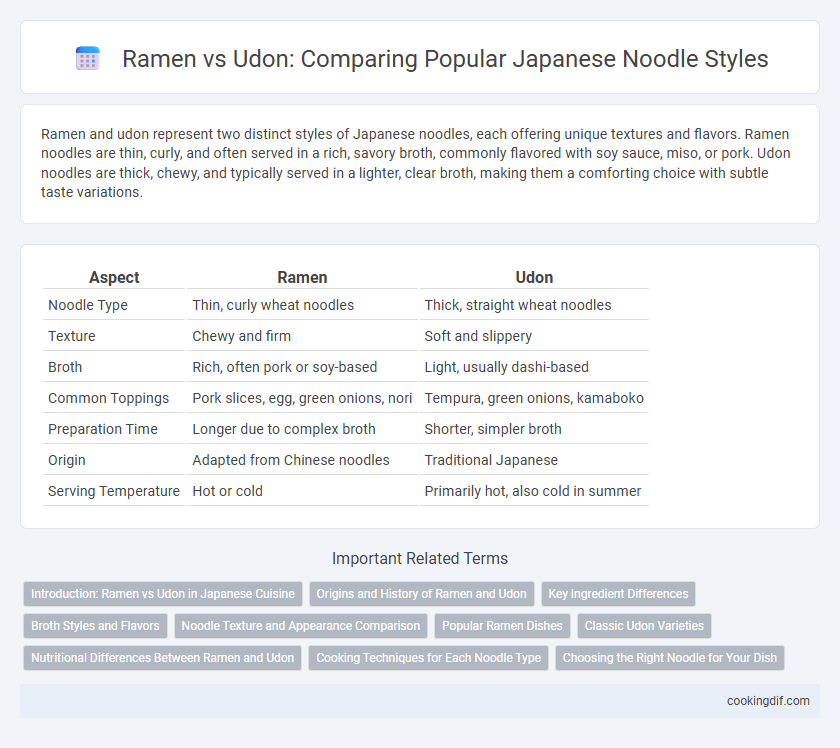Ramen and udon represent two distinct styles of Japanese noodles, each offering unique textures and flavors. Ramen noodles are thin, curly, and often served in a rich, savory broth, commonly flavored with soy sauce, miso, or pork. Udon noodles are thick, chewy, and typically served in a lighter, clear broth, making them a comforting choice with subtle taste variations.
Table of Comparison
| Aspect | Ramen | Udon |
|---|---|---|
| Noodle Type | Thin, curly wheat noodles | Thick, straight wheat noodles |
| Texture | Chewy and firm | Soft and slippery |
| Broth | Rich, often pork or soy-based | Light, usually dashi-based |
| Common Toppings | Pork slices, egg, green onions, nori | Tempura, green onions, kamaboko |
| Preparation Time | Longer due to complex broth | Shorter, simpler broth |
| Origin | Adapted from Chinese noodles | Traditional Japanese |
| Serving Temperature | Hot or cold | Primarily hot, also cold in summer |
Introduction: Ramen vs Udon in Japanese Cuisine
Ramen and udon represent two iconic Japanese noodle styles, each distinct in texture and flavor profile. Ramen noodles are typically thin, wheat-based, and served in a rich broth seasoned with soy sauce, miso, or pork bone, emphasizing bold and savory tastes. Udon noodles are thicker, chewier, and often presented in a lighter dashi-based broth, highlighting simplicity and subtle umami characteristic of traditional Japanese cuisine.
Origins and History of Ramen and Udon
Ramen originated in China and was introduced to Japan in the late 19th century, evolving into a popular Japanese noodle dish characterized by wheat-based, thin noodles served in a rich, meat or soy-based broth. Udon, on the other hand, traces its origins back to ancient Japan during the Nara period (710-794 AD), featuring thick, chewy wheat noodles typically served in a simple dashi broth. Both noodles reflect distinct cultural and historical influences, with ramen representing a fusion of Chinese and Japanese culinary traditions, while udon embodies traditional Japanese noodle craftsmanship.
Key Ingredient Differences
Ramen noodles are typically made from wheat flour, kansui (alkaline mineral water), and salt, giving them a firm texture and yellowish color, whereas udon noodles use only wheat flour, water, and salt, resulting in a thicker, chewier texture. The presence of kansui in ramen dough significantly influences its elasticity and flavor profile, distinguishing it from udon's softer bite. These key ingredient differences contribute to the unique culinary experiences of ramen versus udon in Japanese noodle cuisine.
Broth Styles and Flavors
Ramen broth typically features rich, complex flavors derived from pork, chicken, miso, or soy sauce bases, often simmered for hours to achieve a deep umami profile. Udon broth, on the other hand, tends to be lighter and clearer, primarily made from dashi--a stock of kombu seaweed and dried bonito flakes--resulting in a subtle, savory taste. These distinct broth styles define the culinary experience of each noodle, with ramen offering hearty, bold flavors while udon emphasizes a delicate, clean palate.
Noodle Texture and Appearance Comparison
Ramen noodles are thin, curly, and have a firm, chewy texture achieved by kansui alkaline water, which enhances their elasticity and glossy appearance. Udon noodles are thick, straight, and soft with a smooth, slightly slippery surface, offering a tender bite that contrasts ramen's chewiness. The visual difference is marked by ramen's pale yellow hue versus udon's bright white, reflecting their distinct wheat flour composition and preparation techniques.
Popular Ramen Dishes
Ramen, characterized by its thin wheat noodles and rich, flavorful broth, outshines udon in Japanese noodle cuisine due to its diverse regional variations and complex flavors. Popular ramen dishes such as Tonkotsu, made with creamy pork bone broth, and Shoyu, featuring soy sauce-based broth, highlight the versatility and depth of ramen. Unlike udon, which uses thicker noodles and milder broth, ramen offers a broader range of textures and tastes, making it a favorite among noodle enthusiasts worldwide.
Classic Udon Varieties
Classic udon varieties highlight thick, chewy wheat noodles often served in a light soy-based broth, emphasizing subtle flavors and a smooth texture that contrasts sharply with the thinner, more alkaline, and springier ramen noodles. Key udon styles include Kake Udon, featuring simple dashi broth, and Kitsune Udon, topped with sweet fried tofu, both emphasizing traditional regional ingredients. Unlike ramen's complex, oily broths, udon showcases a clean, mild profile that allows the noodle's glossy texture and broth's umami to shine distinctly in Japanese noodle cuisine.
Nutritional Differences Between Ramen and Udon
Ramen typically contains higher sodium levels due to its rich broth and seasoning, whereas udon noodles are often served in a lighter, lower-sodium soup. Ramen's egg-based wheat noodles provide more protein compared to the thicker, chewy udon made from refined wheat flour, which is higher in carbohydrates. Udon's simpler ingredients result in fewer calories and less fat, making it a lighter option for calorie-conscious individuals.
Cooking Techniques for Each Noodle Type
Ramen noodles are typically cooked in boiling water for a short time, around 2-3 minutes, to maintain their firm and chewy texture, often followed by quick draining to avoid overcooking. Udon noodles require a longer cooking time, usually 8-12 minutes, due to their thicker and denser composition, ensuring a soft and tender bite. Both types benefit from rapid cooling in cold water after boiling to stop the cooking process and preserve their unique textures.
Choosing the Right Noodle for Your Dish
Ramen noodles, thin and curly, are perfect for rich, flavorful broths like miso or tonkotsu, providing a chewy texture that absorbs seasoning well. Udon noodles, thick and smooth, excel in mild, clear soups or stir-fried dishes, offering a soft bite and subtle wheat flavor that complements delicate ingredients. Choosing between ramen and udon depends on the desired broth intensity and texture to enhance the overall Japanese noodle experience.
Ramen vs udon for Japanese noodle style Infographic

 cookingdif.com
cookingdif.com